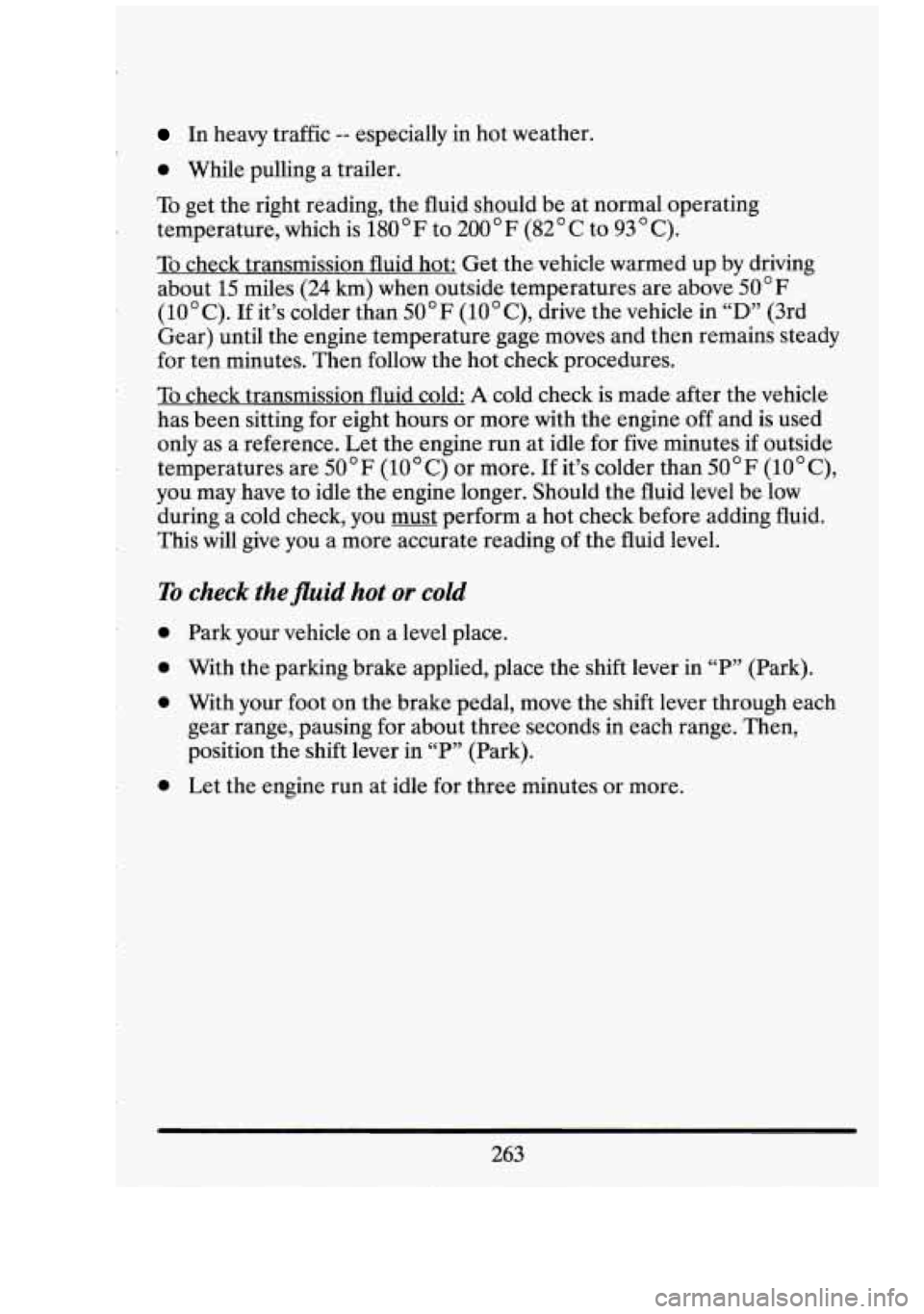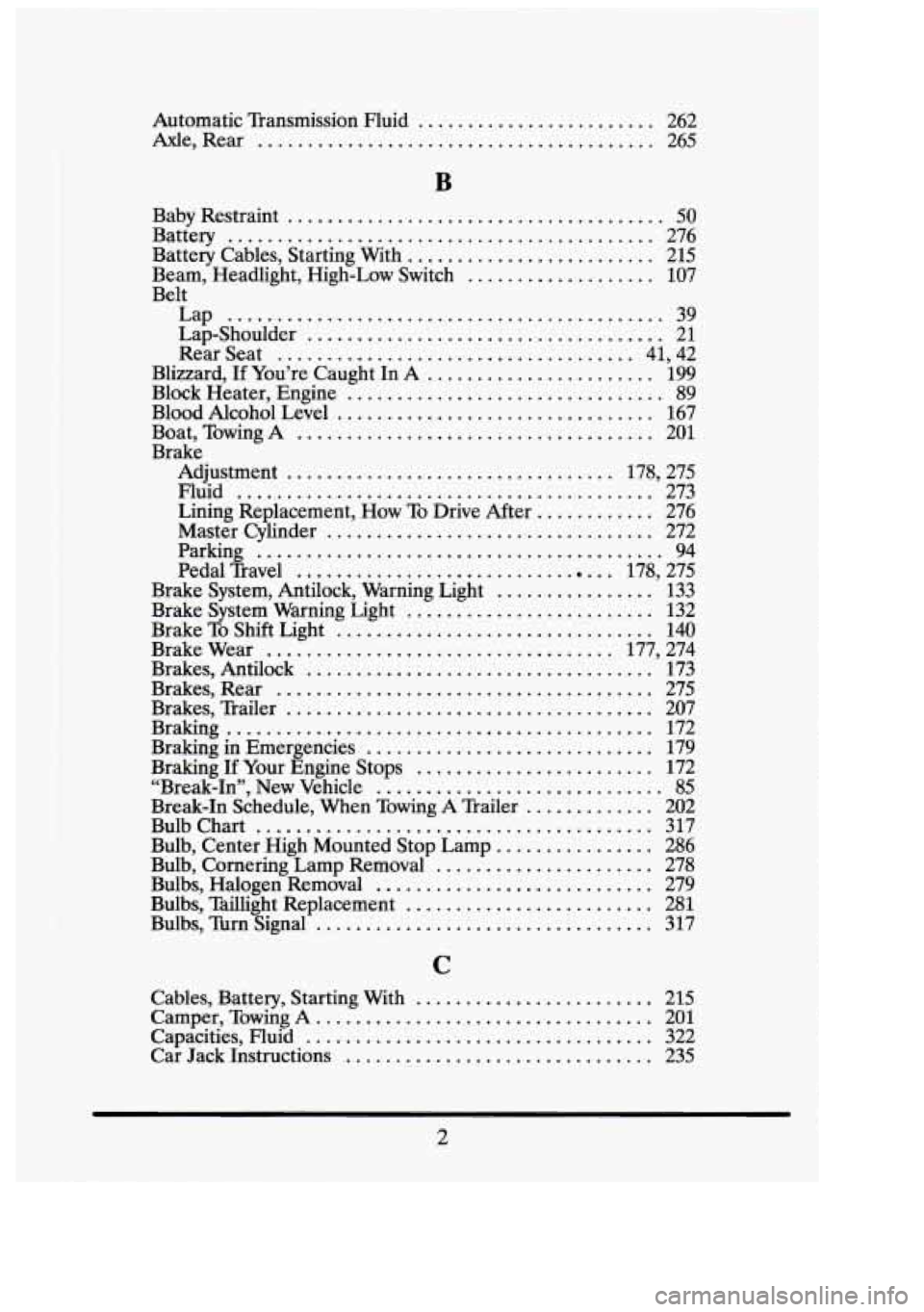1994 CADILLAC FLEETWOOD brake fluid
[x] Cancel search: brake fluidPage 207 of 398

HILL AND MOUNTMN ROADS
Driving on steep hills or mountains is different from driving in flat or
rolling terrain.
If you drive regularly in steep country, or if you’re planning to visit there,
here are some tips that can make your trips safer and more enjoyable.
0 Keep your vehicle in good shape. Check all fluid levels and also the
brakes, tires, cooling system and transmission. These parts can work
hard on mountain roads.
Know how to go down hills. The most important thing to know is this:
let your engine do some
of the slowing down. Shift to a lower gear
when you go down a steep or long hill.
194
13
I
Page 224 of 398

Engine Cooling When Trailering
Your cooling system may temporarily overheat during severe operating
conditions such as;
Climbing grades steeper than 4% at ambient temperatures above
90’Fahrenheit (32O Celsius)
with a loaded vehicle and trailer.
0 Stopping after high-speed driving.
0 Idling for long periods in stop and go traffic.
If the “TEMP” warning light comes on, pull
to the side of the road as
soon as it is safe to do
so. When the vehicle is at a complete stop, shift the
transmission selector to P (Park) and allow the engine to idle. If your
Electronic Climate Control system is on, shut it
off. Do not turn off the
engine or increase engine speed above a normal idle. Within
two or three
minutes the system should cool sufficiently to allow A/C operation to
resume. At that time resume driving at a reduced speed. Return to
normal driving after
10 minutes if the “TEMP” warning light is not
displayed.
Maintenance when Trailer Towing
Your vehicle will need service more often when you’re pulling a trailer.
See the Maintenance Schedule for details. Things that are especially
important in trailer operation are automatic transmission fluid (don’t
overfill), engine oil, axle lubricant, engine drive belt, cooling system, and
brake adjustment. Each of these is covered in this manual. The Index will
help you find them quickly. If you’re trailering, it’s a good idea to review
these sections before you start your trip.
Check periodically to
see that all hitch attaching nuts and bolts are tight.
21
1
Page 276 of 398

r
r
ec
In heavy traffic -- especially in hot weather.
0 While pulling a trailer.
To get the right reading, the fluid should be at normal.operating
temperature, which is
180 " F .to -200 " F (82' C to 93 " C).
To check transmission fluid hot: Get the.vehicle warmed up by driving
about
15 miles (24 km) when outside temperatures are above 50°F
(10" C). If it's colder than 50°F (10" C), drive the vehicle in "D" (3rd
Gear) until the engine temperature gage moves and then remains steady
for ten minutes. Then follow the hot check procedures.
To check transmission fluid cold: A cold check is made after the vehicle
has been sitting for eight hours or more with the engine
off and is used
only as a reference. Let the engine run at idle for five minutes
if outside
temperatures are
50 " F (10 " C) or more. If it's colder than 50 " F (10 " C),
you may have to idle the engine longer. Should the fluid level be low
during a cold checkj you must perform a hot check before adding fluid.
This will give you a more accurate reading
of the fluid level.
To check thefluid hot or cold
0 Park your vehicle on a level place.
0 With the parking brake applied, place the shift lever in "P" (Park).
0 With your foot on the brake pedal, move the shift lever through each
gear range, pausing for about three seconds in each range. Then,
position the shift lever in "P" (Park).
0 Let the engine run at idle for three minutes or more.
263
Page 285 of 398

NOTICE:
. When using concentrated washer fluid, .follow the
manufacturer‘s instructions. for adding water.
..
1 Don’t, mix water with ready-to-use -washer fluid. Water can
cause the solustion to freeze
and damage your washer fluid
tank and other parts of the waiher system.
Also, water
doesn’t clean as well
as washer fluid.-
Fill your .washer fluid tank only 3/4 full when it’s very cold.
This
allows for expansion, which could damage the tank if it
is completely
full.
-0 Don’t use radiator antifreeze in your. windshield washer. It
can damage your washer system and paint.
.. ..
Brake Master .Cylinder
Your brake master cylinder is here. .Xt is filled with. DOT-3..brake fluid.
.There are,only
two reasons why. the brake fluid level in your master
cylinder might
go down. The-fixst is that the brake fluid goesdown to an
acceptable level during normal brake lining wear. When new Iinings are
272
Page 286 of 398

put in, the fluid level goes back up. The other reason is that fluid is
leaking out of the brake system.
If it is, you should have your brake
system fixed, since a leak means that sooner or later your brakes won’t
work well, or won’t work at all.
So, it isn’t a good idea to “top off” your
brake fluid. Adding brake fluid won’t correct a leak. If you add fluid when
your linings are worn, then you’ll have too much fluid when you get new
brake linings. You should add (or remove) brake fluid, as necessary, only
when work is done on the brake hydraulic system.
Refer to the Maintenance Schedule to determine when to check your
brake fluid. See “Periodic Maintenance Inspections” in the Index.
To Check Brake Fluid
273
Page 287 of 398

I
You can check the brake fluid without taking off the cap. Just look at the
windows on the brake fluid reservoir. The fluid levels should be above
“MIN.”
If they aren’t, have your brake system checked to see if there is a
leak.
After work is done
on the brake hydraulic system, make sure the levels
are above “MIN” and below the top
of each window.
What to Add
When you do need brake fluid, use only DOT-3 brake fluid -- such as
Delco Supreme
ll@ (GM Part No.1052535). Use new brake fluid from a
sealed container only, and always clean the brake fluid reservoir cap
.before removing it.
NOTICE:
DOT-5 silicone brake fluid can damage your vehicle. Don’t
use it.
Don’t let someone put in the wrong kind of fluid. For
example, just
a few drops of mineral-based oil, such as
engine oil, in your brake system can damage brake system
parts so badly that they’ll have to be replaced.
Brake fluid can damage paint, so be careful not to spill brake
fluid on your vehicle.
If you do, wash it off immediately. See
“Appearance Care” in the Index.
Brake Wear
Your Cadillac has front-wheel disc brakes and rear drum brakes.
Disc brake pads have built-in wear indicators that make a high-pitched
warning sound when the brake pads are worn and new pads are needed.
The sound may come and
go or be heard all the time your vehicle is
moving (except when you are pushing on the brake pedal firmly).
274
131
I
Page 380 of 398

.
.
. FLEETWOOD INDEX
.
.
.
.
.
c-
.
.
A
Acc (Ignition Key Position) ........................... 86
Adding
Brake Fluid
..................................... 274
Electrical Equipment ......................... 152. 311
Engine Coolant ............................. 227. 266
Engineoil ...................................... 256
Power Steering Fluid ............................. 271
Transmission Fluid ............................... 265
Additives. Engine Oil ............................... 260
Adjustment. Brake ................................. 178
Adult Safety Belt Usage .............................. 20
Air Bags ........................................... 30
Aircleaner ....................................... 261
Air Cleaner & PCV Filter Replace ......... See Maint . Book
Air Conditioner
.................................... 147
Air Outlets ........................................ 146
Airsystem ........................................ 146
Alarm. How To Turn Off Theft ........................ 82
Alcohol. Driving Under The Influence Of .............. 167
Alcohol& Gasoline ................................. 247
AMAX .......................................... 153
AM Radio Reception ............................... 152
AM Stereo Radio Reception ......................... 153
Antenna. Cleaning Radio ............................ 164
Antifreeze ........................................ 266
Antilock Brakes .................................... 173
Antilock Brake System Warning Light ................. 133
Anti-Theft Tips ..................................... 81
Appearance ....................................... 300
Appearance Care. Service and ........................ 245
Arm. Wearing A Safety Belt Under Your ................ 28
Armrest. Storage ................................... 129
Ashtrays .......................................... 126
Assist Handles ..................................... 128
Astroroof ......................................... 125
Audio Systems. Comfort Controls and ................. 146
Automatic Air Conditioning System ................... 147
Automatic Door Locks ............................... 71
Automatic Overdrive ................................ 92
Automatic Transmission .............................. 90
.
1
Page 381 of 398

Automatic Transmission Fluid ........................ 262
Axle. Rear
........................................ 265
Baby Restraint
...................................... 50
Battery ........................................... 276
Battery Cables. Starting With
......................... 215
Beam. Headlight. High-Low Switch
................... 107
Belt Lap
............................................ 39
Lap-Shoulder
.................................... 21
RearSeat
.................................... 41. 42
Blizzard. If You’re Caught In
A ....................... 199
Block Heater. Engine
................................ 89
BloodAlcoholLevel
................................ 167
Boat. Towing A
.................................... 201
Brake Adjustment
................................. 178. 275
Master Cylinder
................................. 272
Parking
......................................... 94
Pedal Travel
................................ 178. 275
Brake System. Antilock. Warning Light
................ 133
Brake System Warning Light
......................... 132
Brake
To Shift Light ................................ 140
Brakes. Antilock
................................... 173
Brakes. Trailer
..................................... 207
Braking
........................................... 172
Braking
If Your Engine Stops ........................ 172
“Break.1n”. New Vehicle
............................. 85
Break-In Schedule. When Towing
A Trailer ............. 202
Bulb Chart
........................................ 317
Bulb. Center High Mounted Stop Lamp
................ 286
Bulb. Cornering Lamp Removal
...................... 278
Bulbs. Taillight Replacement
......................... 281
Bulbs. Turn Signal
.................................. 317
Fluid
.......................................... 273
Lining Replacement. How To Drive After
............ 276
Brakewear
................................... 177. 274
Brakes. Rear
...................................... 275
Braking in Emergencies
............................. 179
Bulbs. Halogen Removal
............................ 279
C
Cables. Battery. Starting With ......................... 215
Camper. Towing
A .................................. 201
Capacities. Fluid
................................... 322
Car Jack Instructions
............................... 235
I !
i3
I
31
nl
2